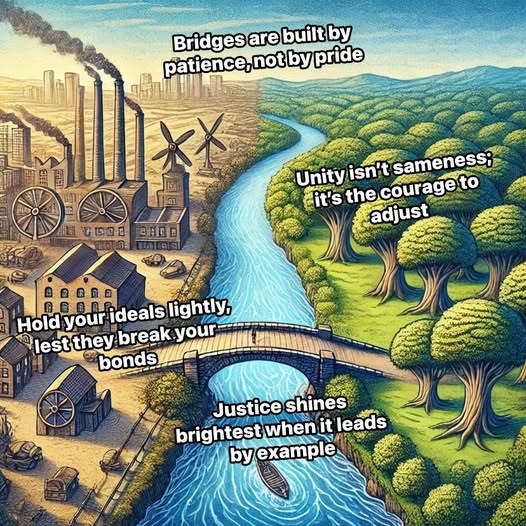
In the heart of a vast and ancient forest lay a village called Eldergrove, nestled between two rivers. For centuries, the villagers had lived in harmony, guided by the belief that unity was sacred. Eldergrove thrived not because everyone agreed on everything, but because they learned to live peacefully despite their differences.
The village square was adorned with a stone bridge, a relic from generations past, arching gracefully over the convergence of the two rivers. This bridge was the only connection between the east and west banks of Eldergrove. It was said to have been built by the village ancestors after years of bitter conflict.
But time has a way of softening memories and hardening hearts. Gradually, the village began to fracture. The people on the east bank, the Rivermakers, prized industry, innovation, and change. The west bank dwellers, the Treekeepers, held tightly to tradition, valuing nature’s timeless rhythms and ancestral wisdom. Though their lives were intertwined, they each believed that their way of life was the ideal. Each believed that their ideals were the highest.
One fateful autumn, a dispute arose. The Rivermakers wanted to widen the river to build a mill, while the Treekeepers refused to let their ancient oaks be uprooted. Meetings turned into arguments. Arguments turned into accusations. Soon, stones—once symbols of unity beneath the bridge—were used as weapons. The bridge became a contested border, a place where insults flew like arrows and tempers burned hotter than the sun.
Among those who watched this escalating discord was a young girl named Sarah. She was neither a Rivermaker nor a Treekeeper, but simply a child who loved both the river’s rush and the forest’s hush. She visited the bridge every morning, listening to its silence, wondering if it remembered the days of peace.
One morning, she found an old mason, Master Bren, carefully examining the cracks in the bridge’s stonework. His weathered face held no anger, only a quiet sadness.
“They will destroy this bridge,” he murmured. “All because each side believes their vision is perfect.”
Sarah tilted her head. “But isn’t it good to seek the best?”
Master Bren smiled faintly. “Ah, child, we are all born idealists. We seek the highest, the purest. But ideals, if held too tightly, can turn people against each other. You see, no two minds share the exact same vision of ‘perfect.’ When we demand that others conform to our ideal, we break the very thing that could connect us.”
Sarah pondered his words, watching the river flow beneath the bridge. A sudden splash startled her. A group of boys from each side had begun hurling stones across the river, their faces twisted with anger. She clenched her fists, feeling a surge of frustration. She wanted to shout at them, to demand they stop. But then she remembered Master Bren’s words. Reacting in anger would only add more fuel to the fire.
Instead, she took a deep breath and did something simple, something unexpected. She picked up a smooth, flat stone and began to skip it across the water. One skip, two skips, three skips. The boys paused, their curiosity overriding their anger.
She called out, “Do you know how many times you can make a stone skip?”
One boy from the Rivermakers sneered. “What does that matter?”
“Everything,” Sarah said gently. “It takes practice, patience, and just the right touch. If you throw the stone too hard, it sinks. If you don’t try at all, it doesn’t move. But if you learn to work with the water, not against it, the stone dances.”
Her words, though simple, carried a deeper meaning. The boys stared at the ripples spreading across the river, a mirror of the growing conflict in their village. Slowly, they dropped their stones.
News of Sarah’s calm gesture spread. Adults who had been stubborn in their anger began to see how their reactions had deepened the divide. They realized that ideals were like stones—when thrown in haste, they harm, but when used with care, they build bridges.
The village leaders came together, not to debate who was right, but to find a way to adjust. They decided to build a smaller mill, preserving the ancient oaks while supporting innovation. Each side gave a little, but they gained something far greater—unity.
Sarah and Master Bren watched as the bridge, once a battleground, became a place of meeting again. The cracks were mended, not just with mortar, but with patience and tolerance.
And so, Eldergrove remembered the truth etched into its very foundation—that the only way to build lasting unity was to live unitedly, not because they were the same, but because they chose to adjust, to forgive, and to work together despite their differences.
The river flowed on, the bridge stood tall, and the stones, once weapons of discord, lay peacefully beneath the surface, carrying whispers of harmony to anyone willing to listen.
The lesson of the story is that justice isn’t always achieved through confrontation; sometimes, it is best demonstrated by setting an example.

